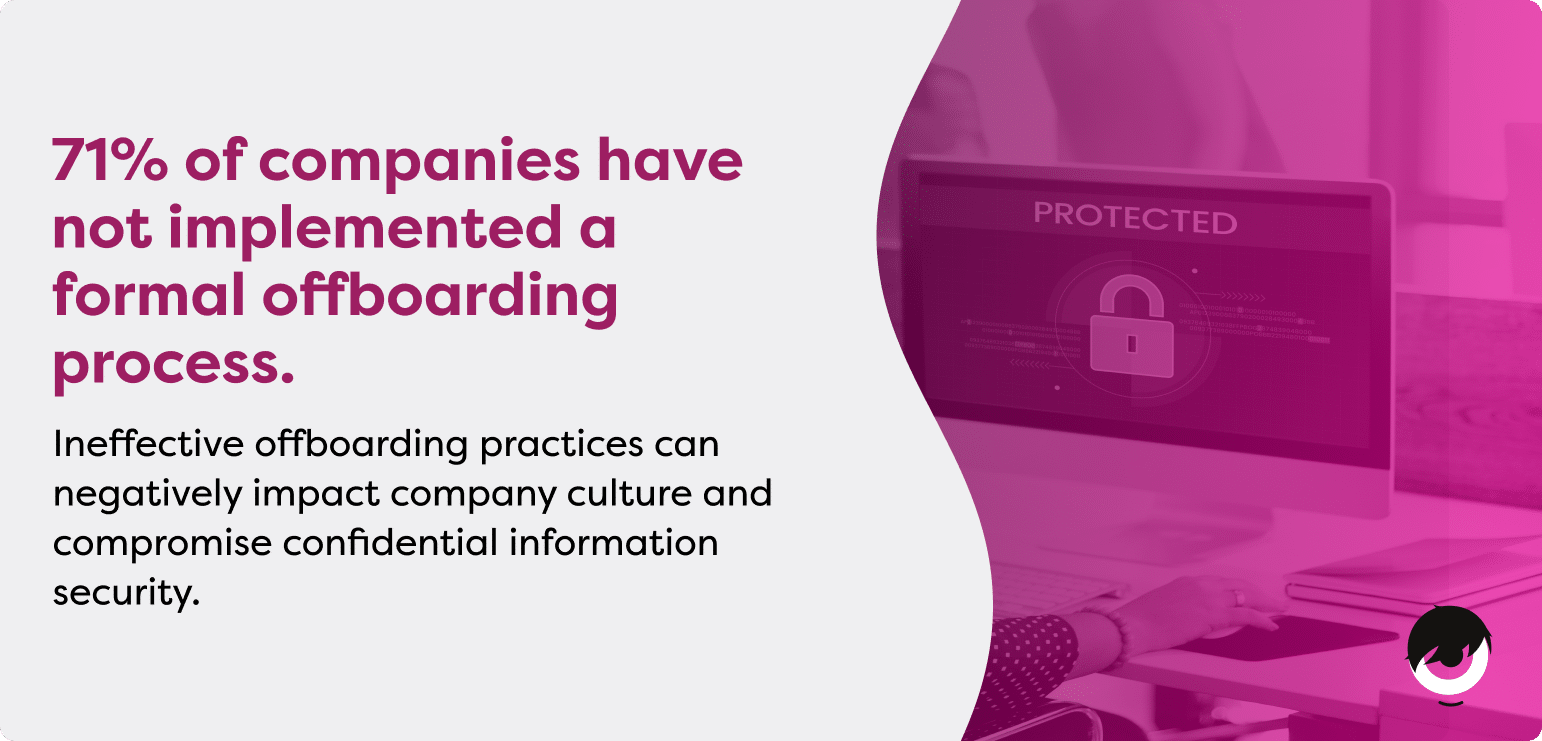Although employee onboarding processes have become a priority for most HR professionals, offboarding management is largely ignored by many companies and remains at the bottom of the list of HR action plans. And yet, implementing good offboarding practices brings numerous benefits and strategic assets. Since seeing is believing, here are essential offboarding statistics that prove you should start prioritizing offboarding processes in your company!
1) 71% of companies have not implemented a formal offboarding process.
Most companies prioritize employee performance management (which is considered essential by 98% of organizations) and onboarding processes (the first 45 days account for 20% of turnover). With so many aspects to manage on a daily basis, HR professionals often forego offboarding processes. The next statistics presented in this article will prove just how much offboarding management is crucial for your company!

2) 20% of companies have experienced security breaches linked with former employees.
Just like onboarding, offboarding processes require organizational skills and comprise a lot of administrative steps. Forgetting to complete a task can lead to security risks in your organization, and there are many offboarding documents you need to prepare and sign, and access to company systems that needs to be revoked. Without formal programs in place, cyber security breaches are bound to occur! Fortunately, they can be avoided by implementing automation tools and effective offboarding plans.
3) 32% of companies have partially automated their employee offboarding process.
And only 5% of companies have a fully automated offboarding process. And yet, automated processes reduce the likelihood of security breaches, human errors and omissions. Your HR department and team leaders are probably already engaged in important projects and will sometimes lack the necessary time and resources to offer a top-notch offboarding process to exiting employees.
Thanks to HR software solutions offering departure management features, you will be able to create offboarding tasks and automate reminders to avoid mishaps and administrative delays. This means that your HR department will have more time to focus on the strategic aspect of offboarding!
4) 93% of exiting employees believe that their feedback is important and can help their former colleagues.
Rightly so: their feedback can make a difference in employee engagement levels and retention rates in your company. They can tell you why they are leaving, what they liked the most during their time in the company, what they would change in your processes, and how they feel about their overall experience with you. In addition, they have nothing to prove and nothing to lose in sharing their straightforward feelings, meaning they are more likely to provide honest feedback you can use to improve your HR practices and strategies in the future.
5) Despite that, the participation rate of exit interviews stands between 30 and 35%.
Which is a shame, considering the benefits that can be gained from effective exit interviews.
If you want to increase participation rates in your company, make sure that you have built a healthy relationship with your employees: good management practices go a long way in creating trust in the workplace. Employees who feel comfortable sharing their doubts and honest feelings with you will be less likely to leave your organization, and more likely to willingly participate in exit interviews if they do.
The interview also needs to be demystified and presented as a simple discussion among former colleagues. You should convey the importance of the exiting employee’s feedback to improve your processes and strategies, and remember that they should not be blamed for leaving or persuaded to stay during the interview. In short, normalize comprehensive offboarding processes and exit interviews, improve your relationship with your teams, and your interview participation rates will grow.
6) Only 4.4% of employers use exit interview questionnaires.
Conducting an exit interview without a discussion plan in mind often leads to failures and missed opportunities.
Of course, your exit interview questionnaires need to be customized depending on the situation and the position of the interviewed employee, but having an exit interview template on hand will help you avoid mishaps and omissions. Moreover, feelings are often easier to share in writing, which makes questionnaires very helpful for collecting honest feedback. The exit interview discussion needs to flow seamlessly, and relevant questionnaires will more often than not be the catalyst of constructive dialogue between the interviewer and the interviewee.
7) 8.2% of employers have more than one exit interviewer present.
Practices and preferences differ on this issue, but one-on-one interviews are often more conducive to personal, stress-free and honest conversations. The interviewer should be an impartial third-party (a member of the HR department or an external consultant, for example), and not the former employee’s manager. Moreover, the interviewer needs to ensure the confidentiality of the discussion to encourage the outgoing employee to share candid insights.
8) The average turnover rate is 18% in Canada.
Although Canadian turnover rates are slowly decreasing, younger generations of employees are more likely to look for new jobs and feel more comfortable leaving their jobs even when they don’t have other opportunities in line.
Failing to invest in the experience of 18% of your employees sounds like a huge missed opportunity: after all, they have valuable feedback and insights to share about their reasons for leaving, and precious skills and knowledge they need to transfer to teammates and future employees before they leave.
9) 50% of employees check online employer reviews before applying for a new job.
… And they will surely avoid your company like the plague if they notice bad reviews from your former employees. Your staff will speak about their entire experience in your organization, including their offboarding process, and you don’t want to leave a bad last impression that will damage your reputation and culture.
Even job seekers who are not checking online employer reviews will rely on word of mouth and former employees’ posts about your company. One way or another, they will try to learn about your corporate culture before applying to a position in your organization. You want to make sure that the employee experience your provide checks out until the very end.
10) 33% of HR professionals say that familiarity with corporate culture and low training needs are the most important benefits when hiring back former employees.
Labor shortages represent major challenges for recruiters and the Talent war is still raging on. In this context, it might be wise to consider hiring back former employees (or boomerang employees) when the opportunity arises. After all, they are the most familiar with your processes and values, and you already know if they are a culture fit for your organization. Moreover, they require less training hours to master company tools and understand organizational goals.
Of course, you need to convince them to come back, which will only happen if they had a positive experience when working with you. Fulfilling their new expectations is also essential. Of course, their offboarding experience is equally important and will convince them – or not – to join your ranks. After all, their last impression of your company is also the freshest in their minds!
As you can see, an effective offboarding process is essential for data safety, a positive employee experience, recruitment strategies, and re-hiring practices. If you want to improve your employee offboarding management, send farewell emails, act on employee feedback gathered during exit interviews, and invest in automated HR solutions to ensure you don’t forget anything!
Use our exit interview template for an effective employee offboarding process:
It’s free, user-friendly, and available in PDF and Google Docs formats!
DOWNLOAD YOUR EXIT INTERVIEW TEMPLATE










